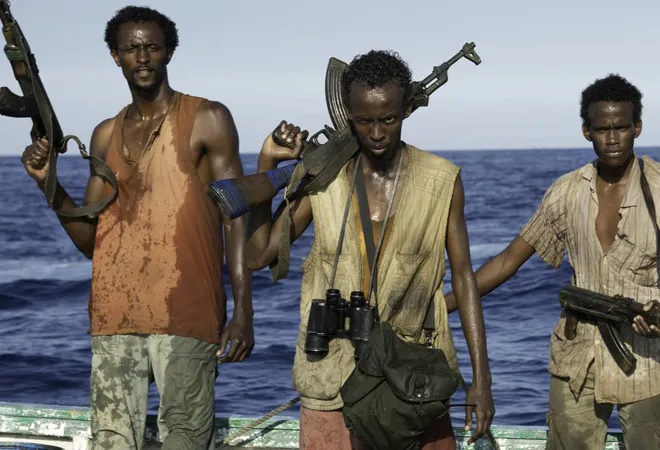
One of the biggest stories in the international media this year has been the revival of Somali piracy. After a period of relative quiescence since 2012, banditry in Somalia's waters has made an alarming comeback, with the first five months of 2017 witnessing no less than 27 pirate incidents. This includes four instances of vessel-capture in the Western Indian Ocean, including two high-profile hijackings of
Aris-13 tanker in mid-March and the
Al Kausar last month. While Aris-13 was the first merchant vessel to be captured in Somali waters in almost five years,
Al Kausar was an Indian dhow. In contrast with 2016, when there was no successful hijacking, this year's record presents a troubling statistic.
In the past two months, Indian naval ships have seen considerable action, though they have involved in anti-piracy patrols off Somalia since 2008. Last week, the INS Sharda, a 2000 tons patrol vessel, thwarted a
piracy attempt on a Liberian vessel in the Gulf of Aden. In a swift
operation involving marine commandos and an armed chopper, the ship's crew carried out a 'board and search' operation on two dhows and five skiffs which had shown "malicious intent" towards a merchant ship MV Lord Mountbatten. As the team of commandos closed in on the hijacked vessel, the bandits reportedly made a high-speed getaway. This was the second time in two weeks that IN ships has scared pirates away in Somalia's waters. In another daring
operation last month, the Indian navy and PLAN freed a merchant ship from the grip of pirates in the Gulf of Aden.
Nonetheless, the surge in pirate activity in Somalia's waters has been perplexing, not least since it contradicts popular expert opinion, which posits that sea-piracy is in a state of terminal decline in the Gulf of Aden. With NATO, the European Union, India, China and Japan still maintaining an active security presence in the region, regularly deploying warships to escort merchant traffic, maritime observers feel pirates have neither motivation nor incentive to carry out fresh attacks.
How and why have pirates returned to Somalia's waters?
For many, understanding the revival of hostage-taking in Somalia is simply a matter of deciphering the mathematics of piracy. Between 2009 and 2013, over 400 pirate attacks
were reported in the Gulf of Aden. Somali pirates principally operated in a capture-to-ransom model, with ransoms of up to $5.5 million per incident. Unlike many other parts of the world where robbery is the main motive, Somali bandits saw piracy as a business. Of the overall $6 billion yearly
estimated cost of maritime piracy between 2008 and 2011 ransom costs comprised more than half. The remainder was made up of notional expenditure incurred by the industry and regional governments on security measures onboard, hiring or armed guards, costs of rerouting of ships, higher insurance and charter rates, and greater inventory financing for cargos.
In the period since 2013, following a near-permanent presence of naval task forces in the Gulf of Aden and the use of on-board armed guards, pirate attacks declined.What became clear, however, was that the ransom component of piracy costs was inversely proportional to the security cost. As investments in security grew, the payoff for pirates declined.
The equation has now reversed with investment in anti-piracy measures falling substantially. According to the State of Maritime Piracy 2016, a
new report released recently by the Oceans Beyond Piracy (OBP), shipping operators are spending less on armed guards and other protection measures, because of which the economic cost of piracy has risen from $1.3 billion in 2015 to $1.7 billion in 2016. With falling trade and shrinking profits, industry has very little left to invest in expensive security arrangements. As the shipping community's vigil has decreased, pirate groups have become more active.
A comparative study of two recent tanker hijackings shows the adverse impact of reduced onboard security. In October 2016, a chemical tanker reportedly fended off an
attempted hijack when the armed guards engaged pirates in a firefight. By contrast, the Aris-13, hijacked last month, had no armed guard, which resulted in its quick capture by the pirates. So desperate have shipping companies been to cut time and costs that merchant ship crews are reportedly being pressured into taking the shorter-Socotra route (between Somalia and Socotra Island) vulnerable to pirate attacks.
The lack of regional stability is another possible cause for the rise in pirate attacks. Since 2009, when piracy took hold in the Gulf of Aden, the state of Somalia has been seen as a
failed state. As law and order deteriorated, attacks became more frequent with higher demands for ransom. Although things improved briefly between 2012 and 2015, Somalia's pathologies seem to have relapsed, aided in significant part by the influence of the radical Islamic ideology (the rise of the Al Shabab and the Islamic State) and declining socio-political conditions in Somalia where the lack of economic opportunity and law enforcement is pushing citizens to adopt the path of crime and violence. According to some recent
accounts, the spate of attacks in the Western Indian Ocean is a direct consequence of the widespread drought and famine in the region, as many of the ships targeted have carried food and oil. This only confirms arguments by noted experts who argue that the roots of piracy in Somalia lie in socio-economic discontent.
Still, there is no discounting the role politics and corruption have played in the resurgence of Somali piracy. Somalia's worst kept secret is that piracy in its waters has been fueled by infighting among its constituent states, a seeming extension of bitter clashes between warring tribes. Somalia's federal government, formed in 2012, has very little control over the autonomous provinces — particularly Galmudug and Puntland that have
been at war with each other for some time. Regional watchers say the
rancor between sub-national forces in Somalia runs deep, with all parties working to undermine the other in a game of political one-upmanship.
In some states such as Galmudug, pirates have taken on the role of the
local coast guard, extracting fines and protection money from local fisher folks. It is not uncommon for pirates in Somalia to refer to themselves as "
saviours of the sea", responsible for the protection of national waters. Hijackings, for many, is a legitimate form of taxation levied in absentia on behalf of a defunct government that they represent in spirit, if not in law. All of this does not obscure the fact that in many coastal towns, there is no security presence at all, leaving vast swathes of the state to the mercy of criminal gang. Regional watchers say the fractious politics of Somalia and the inequities that it has engendered has created the conditions that sustain piracy.
Since 2015, as
political instability in Galmudug and parts of Puntland has been rising, so has the propensity of criminals to make trouble. With corruption, nepotism and clan-wars still endemic in the country, there has been little attempt at reform or governance. Somalia's roadmap for peace is at a standstill as the constituent regions within the fragile federal state keep blocking each other from implementing it.
Significantly, many of the pirates suspected to have carried out the recent attacks are known to have been
patronised by clan-communities regional political leaders. Many of Somalia's "
ocean robbers" have been in
hibernation since 2014, when the Somalia federal government had cracked down on pirates. With the change in the political climate, the criminals are out in the open and freely orchestrating attacks.
Of course, regional governments continue to make a big show of how serious they are about combating the menace of piracy. Many of Somalia's leaders lay the
blame with the international community and regional security forces that have failed to prevent illegal, unreported, and unregulated fishing. As a result, local politicians say Somalia's locals have been forced to pick up the gun.
Nothing, however, changes the fact that piracy in Somalia remains a lucrative business, which many locals find irresistible. The fact that many of the recent attacks have occurred almost 100 miles away from the Somali coast points to the existence of organised, well-funded syndicates, backing piracy.
Now, more than ever, there is need for rules based governance in Somalia. In the absence of a functioning political system in Somalia, there is little hope that illegal fishing and piracy at sea can be effectively tackled. Warships can continue to ward off pirate attacks in the Western Indian Ocean, but the systemic challenges posed by piracy cannot be fully mitigated until pirate financers and supporters are identified and apprehended.
The views expressed above belong to the author(s). ORF research and analyses now available on Telegram! Click here to access our curated content — blogs, longforms and interviews.



 One of the biggest stories in the international media this year has been the revival of Somali piracy. After a period of relative quiescence since 2012, banditry in Somalia's waters has made an alarming comeback, with the first five months of 2017 witnessing no less than 27 pirate incidents. This includes four instances of vessel-capture in the Western Indian Ocean, including two high-profile hijackings of
One of the biggest stories in the international media this year has been the revival of Somali piracy. After a period of relative quiescence since 2012, banditry in Somalia's waters has made an alarming comeback, with the first five months of 2017 witnessing no less than 27 pirate incidents. This includes four instances of vessel-capture in the Western Indian Ocean, including two high-profile hijackings of  PREV
PREV


